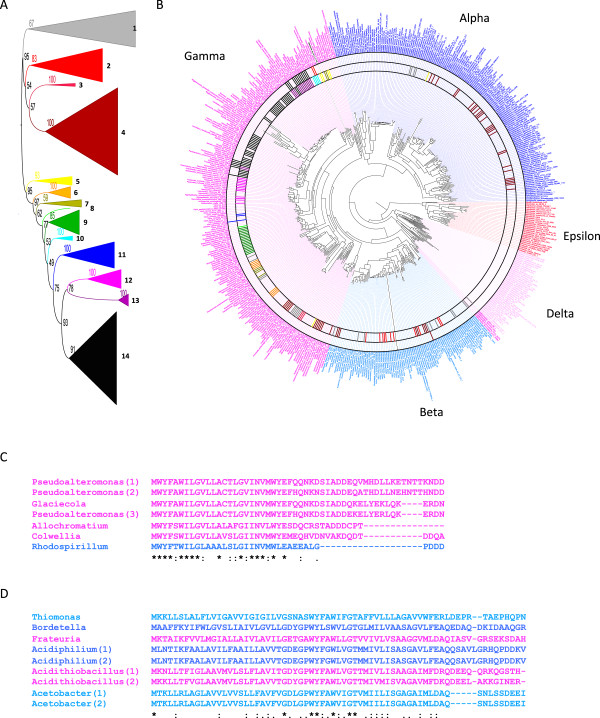Figure 7.

Phylogenetic analysis of CydX. (A) Phylogenetic analysis was conducted using concatenated CydABX protein sequences, and clades of CydABX sequences with strong statistical support are labeled by color. (B) Species containing specific CydABX sequences are labeled on the phylogenetic tree using bars of the same color as their clade in the phylogenetic analysis of the CydABX sequences. Species containing CydX homologues that are not contained in a cydABX operon are labeled with a black bar. The Alpha, Beta, Epsilon, Delta and Gamma labels identify the different classes in the Proteobacter phylum. (C) Alignment of protein sequences of CydX homologues grouped into the “yellow clade” in the phylogenetic analysis. (D) Alignment of select protein sequences of CydX homologues grouped into the “grey clade” in the phylogenetic analysis. Gene names and sequences are shaded corresponding to the color used for that clade in the preceding phylogeny. Species are as follows: Pseudoalteromonas haloplanktis TAC125 (“Psuedoalteromonas(1)”), Pseudoalteromonas sp. SM9913 (“Pseudoalteromonas(2)”), Glaciecola sp. 4H-3-7 + YE-5 (“Glaciecola”), Pseudoalteromonas atlantica T6c (”Pseudoalteromonas(3)”), Allochromatium vinosum DSM 180 (”Allochromatium”), Colwellia psychrerythraea 34H (“Colwellia”), Rhodospirillum photometricum DSM 122 (“Rhodospirillum”), Thiomonas intermedia K12 (“Thiomonas”), Bordetella avium 197 N (“Bordetella”), Frateuria aurantia DSM 6220 (“Frateuria”), Acidiphillium cryptum JF-5 (“Acidiphilium(1)”), Acidiphillium multivorum AIU301 (“Acidiphilium(2)”), Acidithiobacillus ferrooxidans ATCC 53993 (“Acidithiobacillus(1)”), Acidithiobacillus caldus SM-1 (“Acidithiobacillus(2)”), Acetobacter pasteurianus IFO 3283–01 (“Acetobacter(1)”), and Acetobacter pasteurianus IFO 3283-01-42C (“Acetobacter(2)”). Alignments were generated using the program MUSCLE [57]. ‘*’ indicates that the residues are identical in all sequences and ‘:’ and ‘.’, respectively, indicated conserved and semi-conserved substitutions as defined by MUSCLE.
